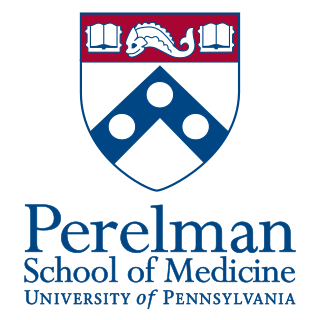
Memorial University of Newfoundland, also known as Memorial University or MUN, is a public university in the province of Newfoundland and Labrador, based in St. John's, with satellite campuses in Corner Brook, elsewhere in Newfoundland and in Labrador, Saint Pierre, and Harlow, England. Memorial University offers certificate, diploma, undergraduate, graduate, and post-graduate programs, as well as online courses and degrees.

Doctor of Medicine is a medical degree, the meaning of which varies between different jurisdictions. In the United States, and some other countries, the M.D. denotes a professional graduate degree. This generally arose because many in 18th-century medical professions trained in Scotland, which used the M.D. degree nomenclature. In England, however, Bachelor of Medicine, Bachelor of Surgery was used and eventually in the 19th century became the standard in Scotland too. Thus, in the United Kingdom, Ireland and other countries, the M.D. is a research doctorate, higher doctorate, honorary doctorate or applied clinical degree restricted to those who already hold a professional degree (Bachelor's/Master's/Doctoral) in medicine; in those countries, the equivalent professional to the North American and some others use of M.D. is still typically titled Bachelor of Medicine, Bachelor of Surgery (M.B.B.S.).
A medical school is a tertiary educational institution, or part of such an institution, that teaches medicine, and awards a professional degree for physicians. Such medical degrees include the Bachelor of Medicine, Bachelor of Surgery, Master of Medicine, Doctor of Medicine (M.D.), or Doctor of Osteopathic Medicine (D.O.). Many medical schools offer additional degrees, such as a Doctor of Philosophy (Ph.D.), master's degree (M.Sc.) or other post-secondary education.

New York Medical College is a private biomedical health sciences university based in Valhalla, New York. Founded in 1860, it is a member of the Touro College and University System.

The Medical University of South Carolina (MUSC) is a public medical school in Charleston, South Carolina. It opened in 1824 as a small private college aimed at training physicians. It is one of the oldest continually operating schools of medicine in the United States and the oldest in the Deep South. The school's main building was designed by Charleston architect Albert W. Todd.
The University of Texas Health Science Center at Houston (UTHealth) is a public academic health science center in Houston, Texas. It was created in 1972 by The University of Texas System Board of Regents. It is located in the Texas Medical Center, the largest medical center in the world. It is composed of six schools: McGovern Medical School, The University of Texas MD Anderson Cancer Center UTHealth Graduate School of Biomedical Sciences, UTHealth School of Dentistry, Cizik School of Nursing, UTHealth School of Biomedical Informatics and UTHealth School of Public Health.

Christian Medical College, Vellore, widely known as CMC, Vellore, is a private, Christian community-run medical school, hospital and research institute. This Institute includes a network of primary, secondary and tertiary care hospitals in and around Vellore, Tamil Nadu, India.

The University of Khartoum is a public university located in Khartoum, Sudan. It is the largest and oldest university in Sudan. UofK was founded as Gordon Memorial College in 1902 and established in 1956 when Sudan gained independence. Since that date, the University of Khartoum has been recognized as a top university and a high-ranked academic institution in Sudan and Africa.

The Perelman School of Medicine, commonly known as Penn Med, is the medical school of the University of Pennsylvania, a private research university in Philadelphia, Pennsylvania. Founded in 1765, the Perelman School of Medicine is the oldest medical school in the United States and is one of the seven Ivy League medical schools. Penn Med is consistently one of the top recipients of NIH research awards and is currently ranked sixth for research among American medical schools by U.S. News & World Report.
The Master of Public Health or Master of Philosophy in Public Health (M.P.H.), Master of Science in Public Health (MSPH), Master of Medical Science in Public Health (MMSPH) and the Doctor of Public Health (Dr.P.H.), International Masters for Health Leadership (IMHL) are interdisciplinary professional degrees awarded for studies in areas related to public health. The MPH degree focuses on public health practice, as opposed to research or teaching. Master of Public Health programs are available throughout the world in Schools of Public Health, Programs in Public Health, Medical Schools, and Schools of Public Affairs. MPH degrees, in addition to including a core curriculum, will usually also let students pursue a specialization in a specific field, such as epidemiology, biostatistics, or health management.
The Graduate School of Biomedical Sciences is one of the eight schools that comprise Tufts University. The Graduate School of Biomedical Sciences (GSBS) is located on the university's health sciences campus in the Chinatown district of Boston, Massachusetts. The school was previously named the Sackler School of Graduate Biomedical Sciences but on December 5, 2019, the university announced it was removing the Sackler name from the school, because of the Sacklers' role in the opioid epidemic through their ownership of Purdue Pharma.

Tabriz University of Medical Sciences (TUOMS) is public medical sciences university located in Tabriz, East Azarbaijan Province, Iran. It is ranked as one of Iran's top medical schools, with more than 5000 students.
Aberdeen University School of Medicine, Medical Sciences & Nutrition contains the Medical School and Dental School at the University of Aberdeen in Scotland. It also provides training and carries out research in medical sciences, nutrition, public health, dentistry, health sciences, physician associate studies at BSc, MSc, and PhD levels. The current school was formed from the merger of the former School of Medicine & Dentistry, School of Medical Sciences, and the Rowett Institute of Nutrition.
University of Otago Faculty of Dentistry is one of the faculties of the University of Otago.

Harbin Medical University is a public university located in Harbin, Heilongjiang, China.

Weifang Medical University is a medical university based in Weifang, Shandong province, China.

The Faculty of Medicine at Dalhousie University, also known as Dalhousie Medical School, is a medical school and faculty of Dalhousie University in Halifax, Nova Scotia, Canada.

The Michael G. DeGroote School of Medicine, known as the McMaster University School of Medicine prior to 2004, is the medical school of McMaster University in Hamilton, Ontario, Canada. It is operated by the McMaster Faculty of Health Sciences. It is one of two medical programs in Canada, along with the University of Calgary, that operates on an accelerated 3-year MD program, instead of the traditional 4-year MD program.
Ian Edwin Lawman Hollands Rusted was a Canadian doctor in Newfoundland and Labrador.
Nigel Francis Scarth Rusted, was a Canadian medical doctor. He is credited with having made outstanding contributions to the medical profession in Newfoundland and Labrador.












